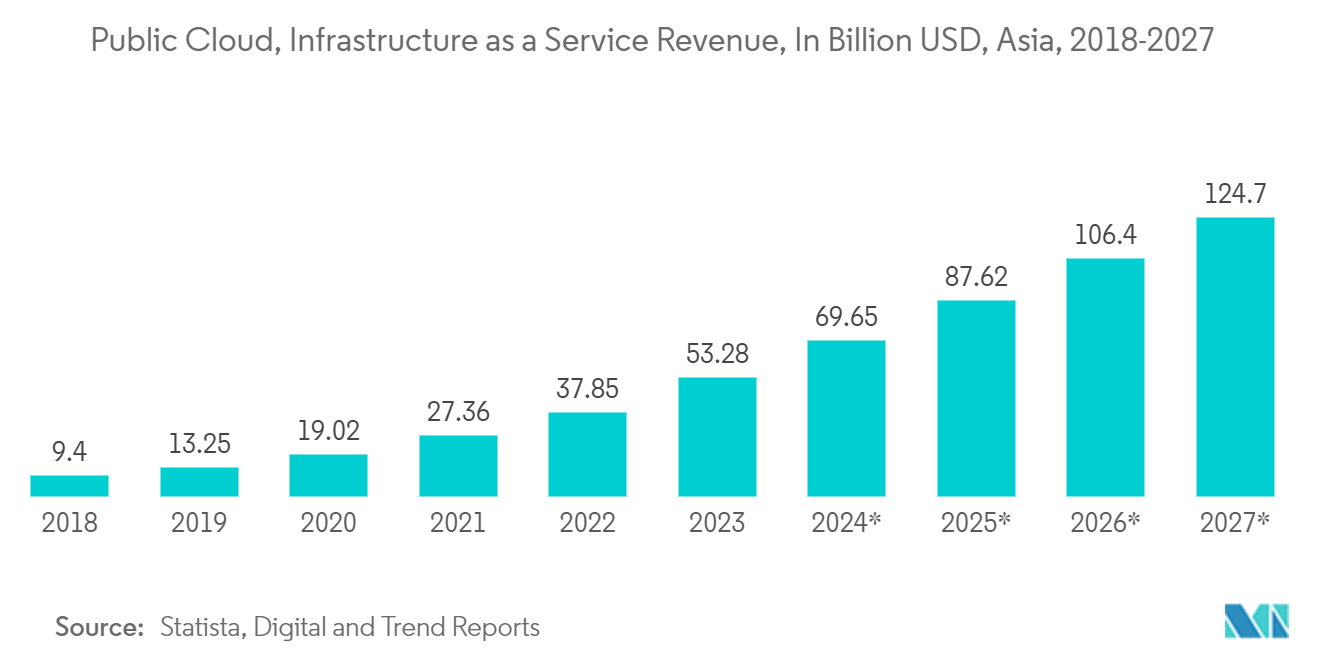Market Trends of APAC Data Center Server Industry
IT & Telecommunication Segment Holds the Major Share.
- The increasing adoption of cloud-based services is driving the expansion of hyperscale colocation services in the region, resulting in increased demand for space in data centers and, consequently, the need for more servers within data centers.
- The demand for cloud services is promising in Vietnam, Thailand, and other Southeast Asian countries. Thailand will adopt hybrid cloud services rapidly over the next five years, with 67% of the respondents in Thailand having agreed upon the adoption plan. The country's leading cloud customers include those in the digital media, finance, retail, and manufacturing sectors. In Vietnam, the rollout of 5G networks is expected to boost the region's digital economy and lead to increased demand for high-bandwidth network infrastructure.
- In Australia, currently, about 10-15% of data is created and processed outside a centralized data center or cloud, but the number is expected to cross 60-70% by 2025, a global trend that is also reflected in Australia. Thus, edge data centers are becoming more viable options for Australian vendors, especially startups. Overall, the market is expected to showcase a major growth rate during the forecast period.
- The Chinese cloud market is expected to grow from USD 30 billion in 2021 to USD 90 billion by 2025 due to the rising demand for cloud computing services. Cloud computing services are delivered to the users in the form of Software-as-a-Service (SaaS), Platform-as-a-Service (PaaS), and Infrastructure-as-a-Service (IaaS).
- Developments such as increasing adoption of cloud services, expansion of 5G Networks, and the ongoing demand for online payments are, in turn, expected to boost the demand for the data center market from the IT and telecom segment, leading to the significant need for the servers during the forecast period.

India is Expected to Have Significant Market Share in The Coming Years
- India is among the major players in the data center sector in the APAC region. The mobile data speed in India is expected to increase from 20.10 Mbps in 2022 to 38.30 Mbps by 2029, registering a CAGR of 8.9%. The arrival of Jio Telecom in the Indian Internet market offered users increased data speeds and low latency. This increased data consumption by users was owing to streaming online content, playing high-quality graphic online games, teleconsultation, and social media video conferencing apps.
- A majority of the current data centers are being built in Mumbai, Chennai, and Hyderabad. The Central and State governments came up with draft data center policies and incentives. Some states like Uttar Pradesh and Telangana have rolled out the policies already. As resources like power and water have become even more scarce in India, market players will strive to make cleaner and greener data centers than ever before. The cooling and supporting backup infra components will evolve into more efficient and cleaner options.
- In terms of policy, the Government of India and various state governments are revising their data center policies to support the infrastructural growth of data centers in India through tax subsidies. Under a national policy framework for data centers, the IT ministry intends to provide up to INR 15,000 crore ( USD 1,812 million) as incentives. The government plans to invest up to INR 3 lakh crore (USD 0.036 Trillion) in the data center ecosystem over the next five years, as per the policy.
- The spread of the Internet and smartphones has progressed rapidly in India in recent years. As reported by the Department of Telecommunications (India), the total number of internet connections in India approached 851 million in the financial year 2023. This marks a near tripling of connectivity since 2015, when there were only 302.33 million connections. Despite approximately 70% of India's population residing in rural regions, urban areas boast a higher number of connections. In 2023, urban areas accounted for 507 million internet connections.


